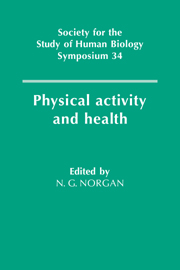Book contents
- Frontmatter
- Contents
- List of contributors
- Acknowledgements
- 1 Introduction
- 2 Comparative aspects of human activity
- 3 Physical activity levels – past and present
- 4 The validity of health measurements
- 5 Developments in the assessment of physical activity
- 6 Two national surveys of activity, fitness and health: the Allied Dunbar National Fitness survey and the Welsh Heart Health survey
- 7 Physical development and childhood activity
- 8 Physical activity and behavioural development during childhood and youth
- 9 Physiological aspects of activity and ageing
- 10 Activity and morale in later life: preliminary analysis from the Nottingham Longitudinal Study of Activity and Ageing
- 11 The benefits of low intensity exercise
- 12 Physical activity, obesity and weight maintenance
- 13 Adherence to physical activity and exercise
- 14 Women's working behaviour and maternal-child health in rural Nepal
- 15 Physical activity and psychological well-being
- 16 Leisure lifestyles: present and future
- Index
2 - Comparative aspects of human activity
Published online by Cambridge University Press: 05 December 2011
- Frontmatter
- Contents
- List of contributors
- Acknowledgements
- 1 Introduction
- 2 Comparative aspects of human activity
- 3 Physical activity levels – past and present
- 4 The validity of health measurements
- 5 Developments in the assessment of physical activity
- 6 Two national surveys of activity, fitness and health: the Allied Dunbar National Fitness survey and the Welsh Heart Health survey
- 7 Physical development and childhood activity
- 8 Physical activity and behavioural development during childhood and youth
- 9 Physiological aspects of activity and ageing
- 10 Activity and morale in later life: preliminary analysis from the Nottingham Longitudinal Study of Activity and Ageing
- 11 The benefits of low intensity exercise
- 12 Physical activity, obesity and weight maintenance
- 13 Adherence to physical activity and exercise
- 14 Women's working behaviour and maternal-child health in rural Nepal
- 15 Physical activity and psychological well-being
- 16 Leisure lifestyles: present and future
- Index
Summary
Introduction
No animal spends the day sitting at a computer terminal, so should the lives of office workers be regarded as unnaturally inactive? No wild animal goes out running for the sake of its health, so should some people be regarded as unnaturally active? This chapter tries to put human activity in perspective by comparing it with the activity of other mammals.
Typical human body masses are about 50 kg for adult women and 70 kg for men. Other mammals range from 2g shrews to 6000 kg African elephants (Macdonald, 1984). In making comparisons, differences of size will have to be taken into account.
Quantities such as metabolic rates, speeds of locomotion and distances travelled will be compared, which vary with body size. Comparisons could be limited to animals of similar size to man (for example, leopards, some antelopes and large kangaroos), but if that was done there would be very limited data. It seems better to use data for mammals of all sizes to find out how the measures of activity concerned generally vary with body mass. It will then be possible to predict typical values for mammals of the same mass as man, and compare man with those.
The monotremes (platypus and spiny anteaters) and marsupials (kangaroos, opossums, etc) are in some respects more primitive than the other mammals, which are known as eutherians. Humans are eutherians, and most of the comparisons in this paper are with other eutherians.
- Type
- Chapter
- Information
- Physical Activity and Health , pp. 7 - 19Publisher: Cambridge University PressPrint publication year: 1992
- 1
- Cited by

